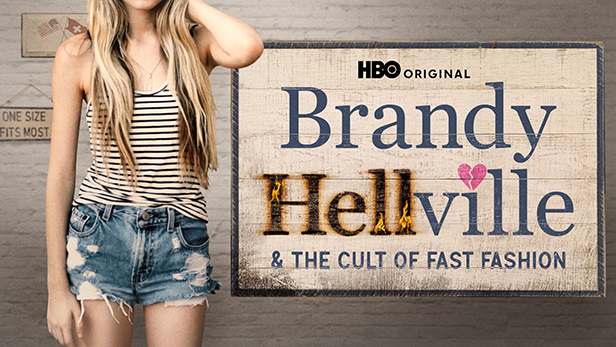April 12, 2024
‘Brandy Hellville & the Cult of Fast Fashion’: 4 Takeaways From New Documentary
The Italian-based brand, beloved by teenage girls for its trendy styles, was exposed for its culture of discriminatory, exploitative and wasteful behavior in an HBO documentary.
Hot water isn’t new for the beachy clothing line Brandy Melville, popular among teenage girls for its “Cali-girl” aesthetic.
Long embroiled in public discourse for its exclusively “one size fits all” styles, the Italian-based brand received even broader criticism for a culture of discriminatory, exploitative and wasteful practices in an HBO documentary released April 9.

HBO’s new documentary examines the discriminatory, exploitative and wasteful practices of fast-fashion brand Brandy Melville. (courtesy of HBO)
Popularized after arriving in the U.S. in 2009, the 54-year-old brand traded the Sicilian shores for Santa Monica with beach-inspired crop tops, flowy skirts and minimalist clothing. The apparel would become synonymous with “cool girl” style, as posts of slim, typically white teenagers sporting “Brandy” went viral on social media.
“You had to have it,” a former employee said in the documentary. “I felt so cool and accepted that I had a piece of Brandy Melville. I remember thinking that the girls who didn’t wear it weren’t as great as I was.”
Former employees described a culture in the stores of appearance-based and racial discrimination, as non-white workers were relegated to the stockrooms and only girls that fit the appearance standard (white and thin) were hired to be customer-facing.
As the latter half of the documentary’s name attests, Brandy Melville is a fast-fashion company that produces cheap, trendy styles at the expense of the environment and low-wage laborers. Here are four takeaways from the documentary. Though they’re focused on the faults of Brandy Melville and fast fashion in general, they’re an object lesson for the promotional products industry as it moves toward more sustainable practices.
1.
Designs were ripped off the backs of employees.

Brandy Melville would often take design inspiration from its employees, mass-producing styles based on outfits they wore at work. (Courtesy of HBO)
Since employees fit the company’s standard of appearance, they represented what customers wanted, according to a former executive.
Designs were sometimes sourced from employee outfits, immortalized in “store style” photos they were required to take during each shift.
A former employee recounted wearing a shirt to work only to later see a Brandy version of the shirt sold in stores. She said brand leadership would often ask workers where one they bought a clothing piece, only to buy that same item and mass-produce it within weeks.
2.
Wasteful culture was spurred by influencers and social media.
The brand’s promotion of “cool girl” style extended to social media influencers. Alongside exposure gained from posts on the brand’s Instagram, influencers would receive large boxes of clothing (more than could feasibly be worn) for free.
And given the trendy nature of the items and churn of new products, one Brandy piece was not enough for the teenage buyers, who were spurred to buy dozens of pieces by ever-popular YouTube hauls and the brand’s general popularity.
85%
of the 36 billion pieces of clothing purchased in the U.S. and Europe each year is discarded.
Regarding overconsumption, former Teen Vogue fashion editor Alyssa Hardy detailed the current inability of the charitable-donation system to handle this volume: 85% of the 36 billion units of clothing purchased in the U.S. and Europe each year is discarded, according to the documentary.
“With numbers like that, where is all of that clothing supposed to go?” Hardy said.
3.
‘Dead white man’s clothes’: One person’s trash becomes Ghana’s burden.
Looking at fast fashion, the documentarians traveled to Ghana, where about 15 million used clothing items from North America, Europe and Australia are dumped weekly. Of this secondhand apparel, about 40% is discarded, according to ABC.
The documentary detailed how the West African nation is forced into this position by the wealthier nations, which threaten the removal of taxation and grant benefits if Ghana doesn’t comply.
“Almost every Ghanian needs to be buying one outfit a week to consume the amount of clothing that’s coming in,” said Sammy Oteng from the Or Foundation.
A 2022 BBC News report delved into the fast-fashion waste issue.
Ghanian women largely carry the burden, as they transport to market bales of clothing weighing over 120 pounds on their heads. The work causes neck pain and scoliosis, according to Chloe Asaam of the Or Foundation.
According to the documentary, this culture of subjugation traces back to the slave trade, as Ghana was the main point of exit for slave ships. Now, the “dead white man’s clothes,” as locals call the items, pollute the water and larger environment of Ghana.
4.
‘Made in Italy’ or made in sweatshops?
The token “Made in Italy” label on Brandy Melville clothes is a dubious moniker, the documentary detailed. Instead of using high-quality Italian artisans, the clothing brand is likely taking advantage of low-paid labor in Italy’s textile hub.
Traveling to Prato in central Italy, the documentarians spoke to Mayor Matteo Biffoni, who discussed a recent influx of fast-fashion manufacturers to the area. The town has long been the textile center of Europe, but the immigration of numerous Chinese workers (who now make up 10% of the population) encourage factories’ growth.
A former executive said Brandy operates a factory in Prato and uses subcontractors there. Although the documentary didn’t confirm whether exploitative labor practices were used by Brandy subcontractors, Biffoni said there were many “not legit” companies essentially operating as sweatshops there.
“It’s a gimmick, because the only Italian thing is the placement of the company and little more,” Biffoni asserted.

Promo for the Planet is your destination for the latest news, biggest trends and best ideas to help build a more sustainable and socially-responsible industry.
